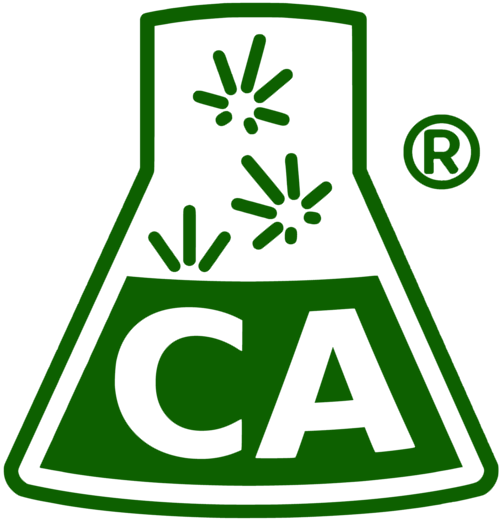Tell me more about the terpenes you test for
Terpenes are organic aromatic molecules that are responsible for the aromas, flavors, and even colors associated with various types of vegetation. They are found in abundance in the Cannabis plant and many other plant species. The numbers vary, but there are easily hundreds of different terpenes that have been identified in cannabis.
More and more attention is being given to how the combination of terpenes in relation to a cultivar’s cannabinoids can help to classify cannabis products and predict their effects. Each Cannabis cultivar consists of its own unique terpene profile which creates a distinguishable effect and smell.
The following are the terpenes most people know about:
- Caryophyllene
- Myrcene
- Linalool
- α-Pinene
- Limonene
- Humulene
- β-Ocimene
- Terpinolene
- β-Pinene
But there are other terpenes we regularly see here at the lab that people are not as aware of. Let’s explore some of those!
α-Phellandrene
- Where it is found: Eucalyptus radiata commonly known as the narrow-leaved peppermint or Forth River peppermint OR Eucalyptus dives, commonly known as the broad-leaved peppermint or blue peppermint.
- Benefits: has been found to reduce pain sensitivity and increase energy levels. It also contains potential anti-cancer properties.
- Organoleptic: spicy; woody
α-Farnesene
- Where it is found: α-Farnesene is found in the coating of apples, and other fruits, and it is responsible for the characteristic green apple scent. α-Farnesene has been isolated from the oil of perilla which belongs to the mint family, Lamiaceae. α-Farnesene is also the chief compound contributing to the scent of gardenia.
- Benefits: muscle relaxer, calming and sedative effects, anti-inflammatory, anti-fungal, and antibacterial properties. Recent studies also suggest that this terpene might even help with tooth decay. (Ishnava, Chauhan, & Barad, 2013).
- Organoleptic: sweet; citrus; herbaceous
β-Farnesene
- Where it is found: β-Farnesene is essential oil of Matricaria chamomilla (Chamomile). β-Farnesene, is also a pheromone in several insect species.
- Benefits: anti-inflammatory, calming, antispasmodic, antibacterial, antifungal, and sedative properties.
- Organoleptic: woody; green vegetative smell with a lavender background
Geranyl Acetate
- Where it is found: Geranyl acetate is a monoterpene derived from a variety of herbs and vegetables, such as sassafras, geranium, lemongrass and carrot.
- Benefits: exhibits antifungal and anti-inflammatory effects.
- Organoleptic: a pleasant floral or fruity rose aroma.
Fenchol
- Where it is found: Fenchol is known for its earthy aroma that naturally occurs in basil. It also comprises up to 16% of the volatile oils of certain species of Aster — a genus of plants that produce starlike flowers, such as the purple dome aster.
- Benefits: antioxidant, anti-inflammatory, anti-microbial, anti-fungal, and analgesic (pain reliever)
- Organoleptic: pine; lemon; camphor
Camphene
- Where it is found: Certain vegetables, fruits and herbs including carrots, pepper, dill, fennel, nutmeg, thyme and more.
- Benefits: When topically applied, this terpene causes a cooling sensation. anti-inflammatory, antibiotic, antioxidant, analgesic, and antifungal. Camphene is proven for its ability to fight infections while reducing inflammation and stress.
- Organoleptic: damp; pungent; herbal, pine.
Less common but regular suspects:
- Guaiol
- Where it is found: Guaiol is found in several plants, especially in the oil of guaiacum, a genus of flowering plants in the caltrop family Zygophyllaceae, and cypress pine.
- Benefits: Antibacterial and antioxidant, proven to be anti-microbial and anti-parasitic.
- Organoleptic: piney and woody aroma with undertones of rose
- Cedrol
- Where it is found: Cedrol is present in Juniper and other essential conifer oils, as well as in some herbs.
- Benefits: sedative, antispasmodic, astringent properties respectively relax muscles and soothe irritated skin. Also anti-septic, anti-fungal and anti-inflammatory qualities.
- Organoleptic: musky; floral; woody
Typical Terpene Combinations
- Caryophyllene
- Composition: Dominant in Caryophyllene, with notable amounts of Limonene and Humulene
- Typical Profile for: Glue varietals, Purple Punch, Cookies varietals
- Myrcene / Limonene / Caryophyllene
- Composition: All three terpenes in roughly equal proportions
- Typical Profile for: Wedding Cake, Kush Mints
- Limonene
- Composition: Dominant in Limonene with notable amounts of Caryophyllene and Linalool
- Typical Profile for: MAC varietals, Gelato varietals
Complete Confidence Terpenes Assay
This is the complete list of terpenes that Confidence Analytics tests for in Washington. Terpenes marked with ** are also available as part of our California test suite.
- Thujene
- α-Pinene**
- Camphene**
- Myrcene**
- β-Pinene**
- α-Phellandrene
- Carene**
- α-Terpinene**
- α-Ocimene**
- m-Cymene
- Limonene**
- p-Cymene**
- β-Ocimene**
- Eucalyptol
- o-Cymene
- γ-Terpinene
- Terpinolene**
- Linalool**
- Fenchone
- α-Thujone
- Fenchol
- Isopulegol**
- Menthone
- Camphor
- Borneol
- Terpineol
- Safranal
- Pulegone
- Carvone
- Citral
- Piperitone
- Isobornyl Acetate
- Carvacrol
- Thymol
- Geranyl Acetate
- trans-α-Bergamotene
- β-Farnesene
- Caryophyllene**
- Humulene**
- α-Farnesene
- α-Bulnesene
- α-Bisabolene
- β-Maaliene
- Selinadiene
- α-Maaliene
- Guaiol**
- Cedrol
- Bisabolol**
